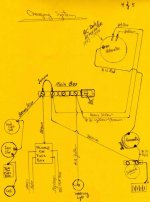BoyRacer
Jedi Warrior
Offline
I'm hooking up a one wire alternator and I'm eliminating the control box from the firewall. It seems to me that I need to tie the 3 brown wires together. I think I can delete the field wire (yellow and green) altogether. I am a bit confused about what to do with the 2 yellow wires that connect to terminal "D". I am not going to use any warning light.

 Hi Guest!
Hi Guest!

 smilie in place of the real @
smilie in place of the real @
 Pretty Please - add it to our Events forum(s) and add to the calendar! >>
Pretty Please - add it to our Events forum(s) and add to the calendar! >> 


